イベント詳細
2020.10.28
【開催報告】ミュージアムトーク2020 (第4回 オンライン開催)
※イベントは終了いたしました。
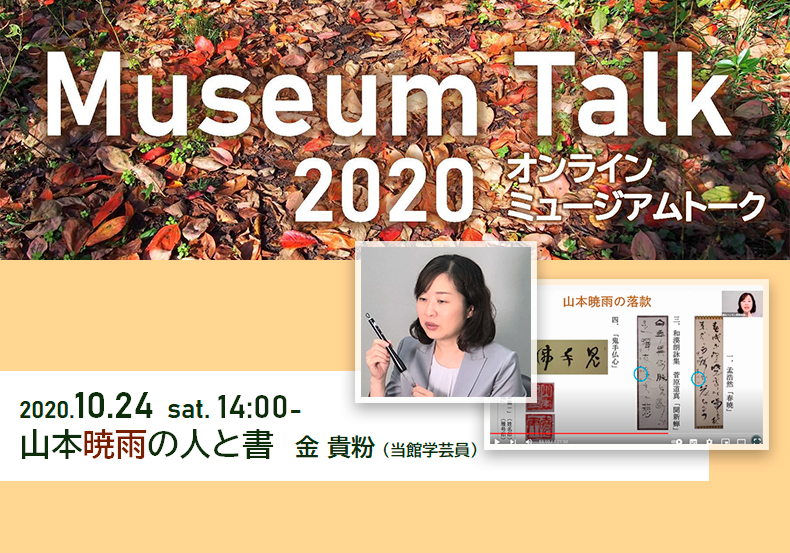
山本暁雨の人と書 当日の記録をYouTubeでご覧いただけます。
講師 金貴粉(きん きぶん 当館学芸員)
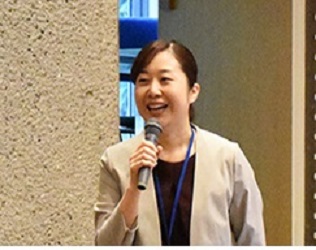
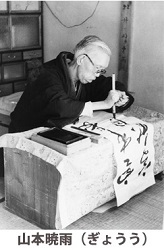
開催概要
2020年10月24日(土)14時 から 15時30分(予定)zoom配信
事前申し込み制 : 定員100人(申込先着順)
山本暁雨の人と書 開催報告
講師 金貴粉(きん きぶん 当館学芸員)
16才で全生病院(現 多磨全生園)に入所し、歌舞伎、俳句、書と様々な文化活動に取り組んだ山本暁雨(本名・熊一 1899年から1973年)の人と表現について考察しました。隔絶された療養所のなかで生き抜く意味を見出すように、山本は歌舞伎公演に打ち込み、自己研鑽を積み、真の芸術を目指しました。また手指と視覚の障害を乗り越え揮毫する姿からは、強靭な意思と表現への一途な姿勢を見ることが出来ます。
当日は書の技法や落款、生前の発表について等、多くのご質問を頂きました。時間内にお答えできなかった内容についてはYouTube動画のアフタートークにてお答えしていますので、そちらもご覧ください。
皆さまから頂いたアンケートのご意見を活かし、今後もハンセン病問題についてさまざまなテーマでミュージアムトークをお届けしてまいります。
アンケートより
- とても分かりやすいお話でした。山本暁雨さん、あの筆の持ち方で、よくぞ…というぐらい素晴らしい書の数々、凄まじい執念と情熱を感じました。
- 文芸活動が盛んだったのは、園外と自由に行き来できず、制約の多い生活だったが故であることが、やりきれない気がしました。
- 今回初めて慣れないZOOMを使って参加しました。ありがとうございました。患者さんが演者となって歌舞伎をしていたこと、病院関係者だけではなく、地域の人が娯楽として歌舞伎を楽しんでいたということにとても驚きました。状況は異なるものの、太平洋戦争中にニューギニアで日本兵が劇団をつくって公演していた話を思い出しました。歌舞伎のお話ももっと聴ける機会があれば嬉しいと感じました。
- とても話が整理されていて判りやすかったです。個人をフォーカスしてハンセン病による 隔離の生活を教えていただくとまた考えさせられる事が有りました。またのお話も楽しみにしております。
- 金貴枌さんは書を習っているとお聞きしていたので、書の解説はさすがでした。また歌舞伎や野菜の品評会の話は初めて聞きました。療養所の中で工夫をしていろいろなことがなされていたのでしょうが、歌舞伎は驚きでしたし、感動しました。遠方の方でも参加できるウェビナーは有効ですね。また参加したいです。ありがとうございました。
- 今回の企画で初めて知った山本暁雨さんでした。お体の不自由さを超え、視力を失ってもなお、書に取り組んでおられていたことに感銘を受けました。また療養所の中でしか生きてはならない強いられた生活で、山本暁雨さんだけではなく歌舞伎などにも携わった多くの方々の姿は、「生きがい」を持つことがそのまま運命に屈しない強さにもつながったのかなと感じました。
- 山本暁雨の書作品は、貴館の展示でも拝見したことがありますが、本日のお話を承り、その鑑賞についてより深いご教唆をいただくことができました。歌舞伎のことはわかりませんが、この方は書芸や俳句はもちろん、散文についても独特な韻律のようなものをお持ちの方だったのですね。思い切って申し上げれば、それは音楽的感性のようなものかもしれず、視力はもちろん、その身体的能力の制約を考えますと、内面的な“心の眼”、ないしは“心の手”の実現だったのかもしれません。本日はたいへんありがとうございました。
- 書についての解説がわかりやすく、文字について全くわからない者が聞いても興味が持てて、たいへん面白かったです。
- ありがとうございました。暁雨さんが過酷な境遇、運命の中、さらに重度の身体障害を抱えながらも、ご自分の人生を切り拓いていかれた姿に触れることができ、私の中にも力がわいてきました。迸るような芸術への思い、才能、努力、それは静かに佇んでおられたという晩年こそ、激しく、研ぎ澄まされたものではなかったかと想像します。暁雨さんの軌跡を丹念に根気強く辿られてこられた資料館職員の方々に深い感謝の思いです。今後も今回のように、作品を通してその方の生きてきた軌跡を学べる機会を企画していただけましたら幸いです。
- 書道雑誌で学んだということに驚きと敬意を感じます。作品はどのような形で保存されているのでしょう。表装はされていますでしょうか。もしそうであればどなたの手によるものでしょう。
- まさに命懸けの書であることがよく分かりました。今回のご講演の中でも出てきたハンセン病とモルヒネ、ハンセン病患者の疼痛、疼痛緩和について今後教えていただきたいです。
- 今まで知らなかった療養所での一人一人の生きかたを、今回も教えていただきました。閉じ込められた空間を作った社会のあり方については、いつまでも問うていかなければなりませんが、その中で気高い人生を送られた方たちに、人間とは何かということを学ばせてもらっています。金貴粉さんの丁寧なご説明に、書の見方も教わりました。これからは療養所で作られた作品だけでなく、他の作品についても見方が変わりそうです。ありがとうございました。
- 山本暁雨についてほとんど知らなかったので今回のお話はとても興味深かったです。療養所内において社会と隔離された中でも自己研鑽への強い欲求があったというお話が印象的でした。改めて暁雨の書を資料館を訪れた際にじっくりと鑑賞したいなと思います。
…ほか多数のご回答をいただいております。ありがとうございました。
開催の様子
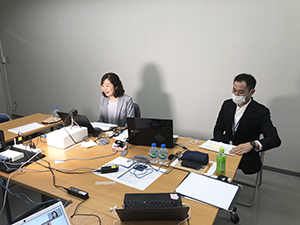 |
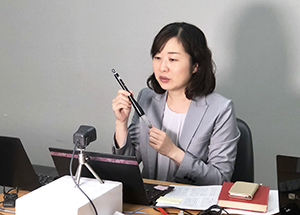 |
